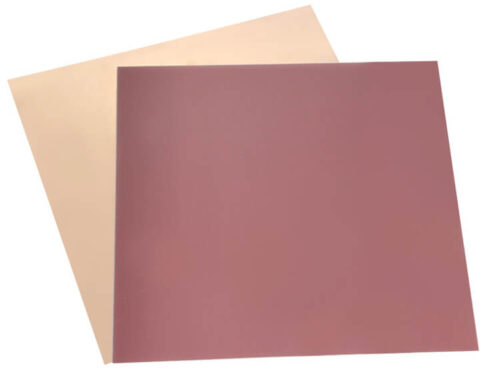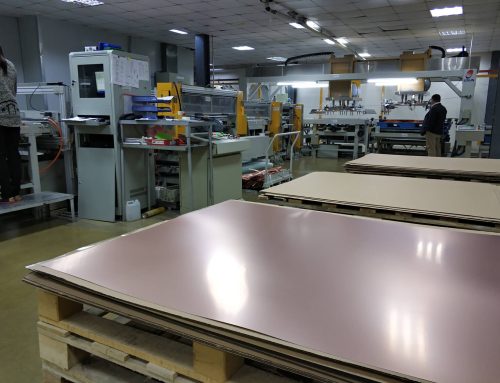DRY(Dried Laminate)
Reason Analysis: DRY is a very troublesome problem, it has a degree of difference, the seriousness is a comprehensive dry, minor occurred in the corner, the reason may be the glass cloth coupling agent and the poor compatibility of resin caused wet out. In addition, it may also be the film overcure so that the resin flow when the pressure is not good, if you find the resin flow of film has low level, it may be a precursor to the dryness of the substrate, and the DRY substrate is prone to delamination during Solderability testing.
Solution: If the problem is the finish of the glass cloth, the supplier must be improved. If the glue flow is low, it can reduce S/G of Varnish, or enhance P/G and Resin Content (R/C), etc. If DRY is not serious, it can also be modified by pressing conditions, such as raising the heating rate, advance pressure, increase pressure, However, this is a temporary solution, the effect is far less material adjustment and improvement was more significant.
WAC/WAE(White at Corner,White at Edge)
Reason Analysis: When the R/F of the film is too high or absorbed water vapor due to poor storage conditions, it will easily lead to Press Flow phenomenon in the press. As the film is from the central diffusion to the periphery by anisortropic way after heated, therefore, the edge Press Flow is large, the R/C also will be low. When this part can not be completely avoided, there will be white at corner, white at edge. Also possible reason is that the heating rate is too fast, resulting in each Book, the outer layer of large temperature difference and press flow uneven, will appear a slight slip to form white at corner when pressure. In addition, there are many tiny bubbles and microvoids in the film, when the R/F is low, the bubble was only rushed to the edge of the board and can not escape the board, will also show white at corner, white at edge.
Countermeasure: If the R/F of film is high, it can be adjusted by increasing the S/G or decreasing the P/G. And a large flow plastic can also be pressed by the conditions to be amended (such as lowering the heating rate, delaying the pressure, etc.) . Also a large R/F can modify by pressing conditions (Such as reducing the heating rate, delaying the pressure and so on). If it caused white at corner, white at edge because the R/F is low, can change Treating Spec (Such as increasing the R / C, P / G) or press-fitting parts (increasing pressure, improving the pressure, increasing the heating rate, etc.) to solve it.
MCB(Microblister)
Reason Analysis: MCB is caused mainly due to the small bubbles are not completely escape and remain on the board, when pressing fit by using of non-vacuum pressing machine, MCB often presents a random distribution of the situation. If using the vacuum system, MCB only occurs edge and corner, sometimes shows lines.If the area is too large to be removed, it will become WAC / WAE. In addition, if the vacuum system leaks or lamination conditions are not properly generated, the press flow is too low can also form MCB.
Countermeasures: It can be improved from the adjustment of treating conditions, such as increasing the R / C, P / G, from the increase of resin flow rate. In addition, the operation cycle of the pressure can also be changed , such as increasing pressure, pressing in advance, increase the heating rate, etc. to overcome.
DEL(Delaminaton)
Reason Analysis: If the film due to sclerosis or poor storage conditions, absorb too much moisture and pressure together, easy to produce a large resin flow conditions, caused R/C become low and reduce the binding force of the glass cloth and resin, and finally, it will evolve into layers under the stress. In addition, the film is over-hardening, if the resin flow is low when pressing may also produce stratification, this point is samiliar with DRY ‘s reasons.
Countermeasures: the DEL that caused by excessive press flow can be adjusted by pressing conditions (such as reducing pressure, delaying the pressure, lower heating rate, etc.). As the over-hardening and generate the layer, you must change the S / G, R / C, P / G and other direction to proceed.
MSL(Measling)
Reason Analysis: may be due to the bubble in the film failed to expel when pressing, and appear opaque white spots. In addition, if the R/C of the film is low or the wet out of the glass cloth itself is poor, white spots tend to be formed at the nodes where the warp and weft yarns are staggered. Another film such as hardening will also produce white spots.
Countermeasures: to strengthen the wet out effect of the glass cloth, and increase the R / C, it can be solved by increasing hardening time if appearing white spots due to hardening insufficient.
WEP/RSV(Weave Exposure/Resin Starvation)
Reason Analysis: the reasons of the two symptoms are quite similar, but the impact part is different. If it occurs in the surface layer, it may be due to the glass cloth is not a complete coverage, and showed a pattern of exposed textures. If occurred in the internal of the middle layer, will form the lack of glue phenomenon in the local place .
Countermeasures: WEP/RSV formed by excessive R / F can be adjusted by pressing conditions (such as lowering the heating rate, delaying the pressure, reducing the pressure, etc.) due to the high press flow. The WEP / RSV caused by poor wet out or low R / C should start with the modification of the glue conditions (such as increasing R / C, P / G, etc.).
Thickness Deviation
Reason Analysis: Usually the substrate due to the relationship between the press flow when pressing, tend to appear thick on the middle and thin on the edge of the board. However, the average thickness is still in the specifications. Thickness deviation is often due to film R/F high, and the press flow is large when pressing, making the R/C decreased, and thus the formation of low thickness. In addition, the combination of film also have a considerable degree influence to the thickness , if want reach a certain thickness, the number of films and cloth species are likely to have several different options, R/C also have differences, once the combination is not will easily lead to the deviation of the thickness.
Countermeasures: The thickness is low due to excessive process flow, it can be adjusted through the adhesive conditions and the pressing operating cycle. For thickness deviation because of improper combination , it need to be empirically and experimentally corrected.
W/T(Warp & Twist)
Reason Analysis: Temperature rise or cooling rate is too fast and cause the substrate to produce internal stress, the internal stress can not be fully released under, it is easy to form W/T. When non-vacuum press is used, in order to completely expel the bubbles, the pressure generally used is relatively large, so it will often produce W/T. Which is especially significant for thin cores. In addition, the film stacking of the warp and weft direction once wrong, improper combination or use of deformation of the steel plate, cover plate, etc., are likely to cause W / T.
Countermeasure: W / T generated by rising or cooling too fast can be started by lowering the rate of temperature change and adding another way such as “Post Bake”. For the the W/T caused by combination of improper or steel plate deformation, you need to give correct solution for the individual reasons, and improved.
PND(Pits and Dents)
Reason Analysis: PND is the basic problem that all the substrates who still can not completely solve until now. Any particles, such as dust which are adsorbed by static electricity at the edge of the film, scraps of steel, scales, dust falling in the air, debris of copper foil, etc., as long as attached to the steel plate, will eventually produce different forms, sizes of the PND.
Countermeasures: immediate and effective approach is to identify the problem of steel, and be re-ground, after cleaning and then on-line to use. The fundamental solution is to minimize the exposure of personnel and the air time on exposure. Therefore, stacking, combination and copper foil cutting and other work, must be in the clean room in an automated manner. In addition, the installation of devices with static elimination, automated stacking and assembly systems, transmission lines, and maintenance of the workplace clean, reduce dust, dust and other measures , all are the method of reducing the PND.
DFM(Dirty Foreign Materials)
Reason Analysis: the use of hot air oven on the glue machine industry, DFM is not completely eradicate the “heart of the pain forever” , Because in the process of baking the drive, the residue often adsorbed in the oven wall, oven hot air outlet Nozzle and air duct, become the black carbide with a small black point, as long as not completely removed, it will fall on the film along with the hot air points, in addition, the glue area of any foreign matter such as mosquitoes, glass fiber, filings, etc. will form DFM.
Countermeasures: DFM reduction mainly depending on the oven cleaning, it should pay attention to including the oven wall, Nozzle, the wind pipe and any dead ends, in addition, the staff in the overlapping area should also cooperate with Sorting, pick out the sheet that has a small black spots, shavings, filaments and other foreign body.
SLP(Slippage)
Reason Analysis: When the sheet that used is bulk material combinations that the rubber content R/C is high , or resin flow rate R/F is high, its compression is easy to produce slip phenomenon. In addition, if each Book’s internal and external temperature difference is too large, resulting in uneven flow is the reason for slip. Poor positioning of the substrate within each Book and the Book will also cause slippage.
Countermeasure: If the sheet R/C or R/F is high, it can be adjusted by combination change and the glue conditions, it can pressure cycle for correction when the resin flow is large (such as lowering the heating rate, delaying the pressure, reducing too Force, etc.). When the temperature difference between the internal and external is large in Book, you can also “reduce pieces” and use reduction production methods to overcome, for the poor positioning, as long as pay more attention when operating and can be improved .
WKL(Wrinkles)
Reason Analysis: WKL is most prone to occur in the 1oz below of copper foil, as long as the process of laying copper foil is slightly uneven, it may produce WKL. In addition, when pressing when the sheet resin flow rate R / F is high ,will also cause WKL due to excessive resin flow.
Countermeasures: the flatness of the laying of copper foil can be enhanced by the operation of personnel training. It can be adjusted by Treating Spec and lamination conditions for the sheet R / F is too high or too much resin flow.
More products informations, please contact [email protected], we have a specialized technical engineers service for you, at the same time we can offer you free samples.


